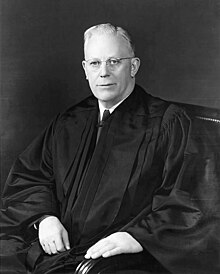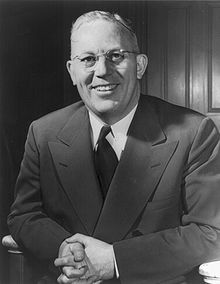Earl Warren
Earl Warren (born March 19, 1891 in Los Angeles , California , † July 9, 1974 in Washington, DC ) was an American lawyer and politician . He served as Governor of California from 1943 to 1953 and as Chief Justice of the United States from 1953 to 1969 . In this capacity, he was controversial to many and remarkable legal decisions involved, in particular for the abolition of racial segregation in schools and to strengthen civil rights . He is also known as chairman of the Warren Commission to investigate the assassination attempt on John F. Kennedy . He is widely recognized as one of the most influential Supreme Court judges and political leaders in United States history.
Early years of his career
Warren's father, Matt Warren (1864-1938; originally Erik Mathias Halvorsen), was a Norwegian immigrant who worked for the Southern Pacific Railroad for a long time . His mother, Emma Christine "Chrystal" Hernlund (1858–1940), was an immigrant from Sweden . The assumption by some authors that Warren's Scandinavian origins influenced his later liberal politics is contrary to the fact that he was initially rather conservative. Warren grew up in Bakersfield , a small town about 180 kilometers from Los Angeles. Here his father was murdered by an unknown person in a robbery.
He studied at the University of California at Berkeley , where he received his bachelor's degree in 1912 and his law degree in 1914, and was admitted to the bar that same year. He worked for a year with the oil company Associated Oil Co. in San Francisco and then joined the law firm Robinson et al. Robinson at. In 1917/1918 he did his military service as a lieutenant in World War I, but was not deployed overseas. In 1919 he assisted the Justice Committee of the Californian Parliament, was from 1919 to 1920 Deputy City Attorney in Oakland and then in the same capacity in Alameda County , before becoming a prosecutor in 1925 with the support of Republican local politician Joseph R. Knowland (editor of the Oakland Tribune ) was appointed; the predecessor suddenly quit. He was elected three times, serving a total of twelve years as the Oakland Attorney General. In doing so, he acquired the reputation of being authoritarian and tough against crime.
Governor of California
Warren was next a prominent figure in California. During his tenure, he was appointed a board member of the University of California ( Board of Regents of the University of California ). In 1939 he became Attorney General of California; three years later he ran in the gubernatorial election campaign as Republican (in the Democratic primary he was second) and won the election against incumbent Culbert Olson with 57 percent clearly. By 1946, Warren was so popular that he won both party primaries. That is why he only had the non-party, little-known Henry R. Schmidt as an opponent in the general election in the autumn, whom he was able to beat with 91 percent of the vote. In November 1950, he ran for a third term, the first time he only ran for the Republicans, and prevailed clearly against James Roosevelt , a son of former President Franklin D. Roosevelt . In the 1950 election, 64 percent of Californian voters still voted for the incumbent, a figure that none of his successors has achieved to this day.
During his tenure, Warren supported President Franklin D. Roosevelt's later very controversial decision to deport American citizens of Japanese descent to so-called "internment camps" like Manzanar . This falls at the height of an almost hysterical fear of a Japanese invasion of California after Pearl Harbor .
A plus point of his tenure was the expansion of the huge public university system of California, driven by Warren and Clark Kerr , one of the foundations of the amazing upswing of California after the war, also in the scientific field. The division of the California university system resulted from their plans: the University of California with nine areas that emphasized research and pure academic endeavors, and the California State University , a larger system with 19 areas. California State University trains teachers and also offers hands-on programs; in this sense it is somewhat similar to the universities in Germany or the former polytechnic schools in England.
Warren ran for the first time seriously as a Republican candidate for the 1948 presidential election - until then, he had only participated in the California primary in previous years - and took first place in the unusually ambiguous primary with a good quarter of the votes nationwide; however, the fourth-placed Thomas E. Dewey (12%), governor of New York , was nominated as a candidate at the Republican convention , while Warren, beaten 3%, was left with only the unanimous nomination as a vice-presidential candidate. The election result turned out to his disadvantage, the Democratic incumbent Harry S. Truman and his runner-up candidate Alben W. Barkley unexpectedly won. In 1952 he ran again for the presidency and this time came third with 17% in the primary elections, but due to the close competition between Robert A. Taft and Dwight D. Eisenhower , he hoped for a nomination as a compromise candidate, with Richard Nixon his Assistance guaranteed. After Nixon switched sides at Eisenhower's offer to run him for the presidential term, Warren felt a lifelong loathing for him. In 1957 Warren was elected to the American Academy of Arts and Sciences .
With over ten years of service, Warren was California's longest-serving governor. In October 2013 he was overtaken by Jerry Brown , who after two terms from 1975 to 1983 has been the head of government of the West Coast state again since 2011. However, Warren remains the governor with the longest uninterrupted tenure.
Serving the United States Supreme Court
1953 was the turning point in Warren's life. US President Dwight D. Eisenhower appointed him Chief Justice of the United States, Chief Justice of the Supreme Court . He then resigned as Governor of California, making his Lieutenant Governor Goodwin Knight assumed the highest office in the west coast state.
Most observers (including President Eisenhower) expected Warren to act cautiously and conservatively as chief judge, but the opposite occurred: he surprised with committed decisions that would have a major impact on American society. Eisenhower later described the appointment of Warren as "the biggest mistake he made" ("the biggest damn mistake I ever made").
The most famous decision was Brown v. Board of Education , 374 US 483 (1954). This case formally ended the long-established racial segregation or segregation in public schools in the south. The relentless opposition to it in the southern states and the committed struggle of the civil rights movement to implement it caused great unrest that lasted more than twenty years.
- Rubrum and implementation order of the court of May 17, 1954
Warren's court also established the “one-man-one-vote” principle: the votes of every voter must be equal. This move limited the disproportionate power of conservative voters in the countryside.
From the case of Miranda v. Arizona came up with the ruling that ordered police to declare their civil rights to suspects when arrested. This regulation met with outrage among police officers, prosecutors, the state justice ministers and FBI chief J. Edgar Hoover . The so-called “legal activism” of the “Warren Court” has been heavily denounced by conservative circles. One year after Miranda v. Arizona drafted Earl Warren's unanimous decision in the Loving v. Virginia , through which the prohibitions of so-called "multiracial" marriages between whites and non-whites in various states were rejected as unconstitutional.
Immediately after the assassination of John F. Kennedy , the new president, Lyndon B. Johnson , appointed Warren to head a special commission (the " Warren Commission ") to collect and investigate the facts of the assassination. Eventually the commission decided that only the alleged assassin, Lee Harvey Oswald , was responsible. This conclusion was called "the lone gunman theory". Many critics remained skeptical because there were several contradictions in the Commission's report, and today many people still believe in various conspiracy theories . Among other things, it is argued that it would have been impossible for Oswald to fire three shots so quickly in succession. In addition, the majority of the eye and ear witnesses of the attack had seen a shot by the so-called Grassy Knoll. Despite everything, Warren remained firm.
In 1969, Warren retired despite the fact that all Supreme Court justices can serve for life. His colleagues valued him as the "super boss", although he was the target of many conservatives. At that time there were countless posters in the southern states with the motto: “Impeach Earl Warren!” (“Remove Earl Warren from office!”). After his voluntary resignation, President Richard Nixon named lawyer Warren E. Burger as his successor.
Warren died in Washington on July 9, 1974 and was buried in Arlington National Cemetery.
literature
- Ed Cray: Chief Justice. A Biography of Earl Warren. 1997
- Michael Belknap: The Supreme Court under Earl Warren, 2005
- Jim Newton: Justice for All. Earl Warren and the nation he made, 2006
- Lucas Powe: The Warren Court and American Politics, 2000
- Bernard Schwartz: The Warren Court. A Retrospective, 1996
- G. Edward White: Earl Warren. A public life, 1982
- Earl Warren: The memoirs of Earl Warren, 1977 (goes to 1954)
- Henry M. Christman (Editor): The Public Papers of Chief Justice Earl Warren, 1959
- Morton Horwitz The Warren Court and the Pursuit of Justice , Hill and Wang 1998
Web links
- Earl Warren in the database of Find a Grave (English)
- Earl Warren in the nndb (English)
- Earl Warren in the National Governors Association (English)
- Profile the Governor's Library (English)
Individual evidence
- ↑ The 100 Most Influential Figures in American History ( en-US ) December 1, 2006.
- ^ Ross Douthat: They Made America ( en-US ) December 1, 2006.
- ↑ Harry Truman: Earl Warren - A Tribute .
- ↑ Earl Warren ( en )
- ↑ Earl Warren, 83, Who Led High Court In Time of Vast Social Change, Is Dead .
- ^ William D. Pederson: Earl Warren ( en )
- ^ Christof Mauch: The American Presidents CH Beck Munich ISBN 978-3-406-58742-9 p. 344/45
| personal data | |
|---|---|
| SURNAME | Warren, Earl |
| BRIEF DESCRIPTION | American politician and Chief Justice of the United States |
| DATE OF BIRTH | March 19, 1891 |
| PLACE OF BIRTH | Los Angeles , California |
| DATE OF DEATH | July 9, 1974 |
| Place of death | Washington, DC |









